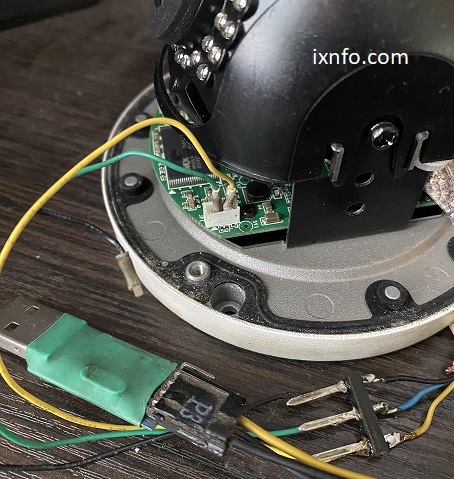I sketched another example of a script for backing up the Huawei MA5800 configuration.
Continue reading “Huawei MA5800 – Configuration Backup Script”Tag Archives: TFTP
Recovery Hikvision DS-2CD2132F-IS
Once I came across an IP-camera Hikvision DS-2CD2132F-IS, which was flashed with new firmware from another model, respectively, the IP camera stopped working and rebooted cyclically.

Install and configure tftpd-hpa
I will give an example of installing a tftpd server tftpd-hpa.
Continue reading “Install and configure tftpd-hpa”Restore Huawei SmartAX MA5600 Configuration
On the test, I will give an example of creating a backup of the Huawei SmartAX MA5683T configuration to a TFTP server, as well as its restoration.
Recovery is often useful when you need to quickly return to the previous configuration or to make massive changes to the configuration or to profiles that are active and used by the ONT.
OLT reboot is required.
Ubiquiti (UBNT) device recovery
It happened when during the process of updating the firmware of RocketM, NanoBeam, NanoStation and other Ubiquiti devices power was lost, or there were some other problems after which the device could not be accessed via the web interface and it did not work.
Continue reading “Ubiquiti (UBNT) device recovery”Configuring DHCP+TFTP for DOCSIS
Recently, it was necessary to configure the issuance of IP addresses to several old DOCSIS modems and the host located after the modem.
At hand was the Arris Cadant C3 and Thomson TCM-420 modems.
First of all, let’s start a DHCP server that will issue IP addresses to modems, for example, as I described in this article – Installing and configuring isc-dhcp-server.
And also we will launch a TFTP server on which there will be files for modems, for example, as I described in the article – Installing and Configuring a TFTP Server
Installing and Configuring a TFTP Server in Ubuntu
TFTP (Trivial File Transfer Protocol) It is mainly used for initial loading of diskless workstations. TFTP, unlike FTP, does not contain authentication capabilities (although it is possible to filter on the IP address) and is based on the transport protocol UDP.
atftpd server
atftp client
Install:
sudo apt-get install atftpd atftp
The server uses the port: 69/udp
The default directory is /srv/tftp if it does not exist, create:
sudo mkdir -p /srv/tftp
sudo chown nobody /srv/tftp
To start automatically, you need to comment out (put # at the beginning of the line) the start line in /etc/inetd.conf:
#tftp dgram udp4 wait nobody /usr/sbin/tcpd /usr/sbin/in.tftpd –tftpd-timeout 300 –retry-timeout 5 –mcast-port 1758 –mcast-addr 239.239.239.0-255 –mcast-ttl 1 –maxthread 100 –verbose=5 /srv/tftpd
And change the value of the variable USE_INETD in the file /etc/default/atftpd from true to false.
This can be done in any editor, for example using nano:
sudo nano /etc/default/atftpd
(in the editor the key combination Ctrl+O is used to save the changes, and Ctrl+X to exit).
To apply the changes and run atftpd, run the following command:
sudo /etc/init.d/atftpd restart
Done, TFTP server should work, accept and return files from the /srv/tftp directory.
See also my articles:
IPTables rules for TFTP
Starting a TFTP server in Windows
Configuring DHCP + TFTP for DOCSIS
Install and configure tftpd-hpa
IPTables rules for TFTP
To open the TFTP port in IPTables, we will run the rule:
Continue reading “IPTables rules for TFTP”Starting a TFTP server in Windows
One of the options for running the tftp server on Windows is to download and run the application from the link http://tftpd32.jounin.net/tftpd32_download.html
Continue reading “Starting a TFTP server in Windows”Backup configuration of TP-Link switches
I wrote a script for backup configuration of TP-Link switches.
The script runs on Linux where the TFTP server is running, it is connected via telnet to the switch and the configuration command is sent to the specified TFTP, when the telnet connection is closed, the file is moved to the desired directory, and the last command deletes files longer than 30 days, as more of them I do not need to store.
You can also make a copy of all the files in the cloud every month.
As you can see, before entering a password in the script, you can not pause.
#!/bin/bash
{
echo "PASSWORD";
echo "enable";
echo "PASSWORD";
echo "copy startup-config tftp ip-address 192.168.0.5 filename tplink";
sleep 2;
echo "exit";
sleep 1;
echo "exit";
} | telnet 192.168.0.110
mv /srv/tftp/tplink.cfg /backups/devices/tplink/`date +%Y-%m-%d`_tplink.cfg
find /backups/devices/tplink/ -type f -mtime +30 -exec rm {} \;